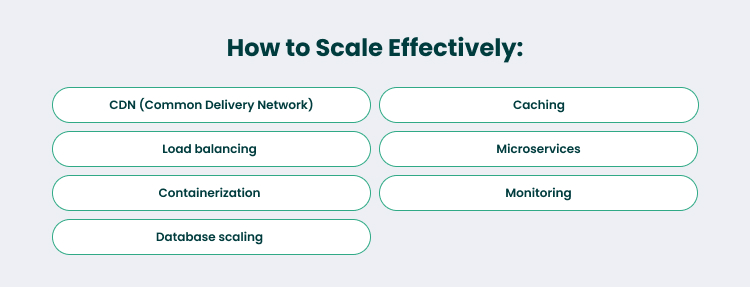Imagine it’s a week before Black Friday. You’re managing an e-commerce platform that’s about to be hit with a flood of shoppers looking for deals. No doubt, your marketing team has done an incredible job of driving traffic. But the huge number of visitors is overloading your servers.
Pages are loading slowly and checkout is taking too long. It’s a nightmare scenario – when your platform needs to perform its best, it’s struggling to keep up.
This isn’t just a problem for Black Friday. It could be Halloween or Christmas when you’re overwhelmed with customers and their orders. Traffic spikes, and once again, your site starts to lag. Customers become frustrated and abandon their carts, leading to lost sales. This means your current setup can’t handle these surges.
Over the years since becoming DevOps at Forbytes, I’ve understood that a scalable architecture becomes a lifesaver in these situations. It’s like having a system that grows with you – able to easily handle low-traffic days but ready to expand during peak times.
Whether it’s ramping up extra servers or using cloud solutions that can instantly scale based on demand, a scalable architecture ensures your platform stays fast, responsive, and reliable no matter how many shoppers come knocking.
Let’s be honest – no one wants their site to crash during the most important sales events of the year. A scalable approach doesn’t just address short-term issues; it prepares your platform for long-term success.
Curious about how it all works? Read our article to discover why a scalable architecture is not just a technical solution, but also an integral part of the business growth strategy.
What Is a Scalable Architecture?
Before diving into the details of scalable architecture, let’s first talk about scalability. What does it mean for a system to be scalable? In simple terms, scalability refers to a system’s ability to handle increased workloads by adding additional resources when needed.
With a scalable architecture, your system can handle increased workloads without major changes. This architecture automatically adjusts to the necessary size to manage workloads effectively during peak periods. When the busy season ends, the system can scale down to an optimal size, saving resources in the process.
At its core, a scalable architecture is built on three main principles: speed, high availability, and cost-effectiveness. These principles help ensure the system runs smoothly while keeping expenses in check.
To Scale Vertically or Horizontally?
There are two main approaches to scaling your app: vertical and horizontal. So, what exactly is vertical scaling?
Imagine you have a server hosting multiple databases, but not all of them can scale up efficiently on their own. In this case, horizontal scaling isn’t an option. Instead, vertical scaling is used. This involves increasing the server’s resources when the workload on the database grows, such as adding more CPU, increasing memory, or expanding disk capacity. Many off-the-shelf services come with built-in vertical scaling capabilities.
However, the drawback of vertical scaling is that you often need to take the server offline to add more resources. This downtime can cause disruptions, which is why vertical scaling is less common compared to horizontal scaling.
Horizontal scaling, on the other hand, is more widely used. For instance, let’s say you run a furniture e-commerce site, and on Black Friday, traffic jumps from 1,000 requests to 10,000. Your task is to ensure the server can handle this spike without crashing. If you had 10 servers before, you may need 100 now. For this to work, your app must be designed to handle the increased load. Both the software and its architecture must be built with horizontal scaling in mind.
In some situations, you may need to scale both vertically and horizontally. For example, you might need to add more resources and modify components without causing downtime. The approach you take depends on the database type, app type, and specific requirements of your system.
Contact our experts today to find out how scalable architecture can make it easy to handle growing demands and keep your business moving forward.
Basics of Scalable Architecture
It’s important to understand that there isn’t a single model for a scalable architecture. Instead, it evolves organically over time, driven by various factors.
First, the unique needs of customers inspire developers to experiment and discover the best solutions. For instance, combining vertical and horizontal scaling can boost a system’s performance and efficiency.
Second, scaling is not a one-and-done event; it’s an ongoing process that adjusts to changing demands and requirements.
Third, scalable architecture comes from integrating different solutions that DevOps teams and software developers create together. Their teamwork is crucial in creating a system that can grow and adapt seamlessly.
Fourth, the emergence of cloud solutions from companies like Amazon, Microsoft, and Google has made scaling a lot easier. With these services, you can simply provide your code, and they’ll manage the scaling for you. While it’s convenient, it can also be costly.
For example, Google Cloud Platform offers services like Cloud Run, App Engine, and Cloud SQL to help scale applications efficiently. Similarly, Amazon Web Services provides RDS (Relational Database Service) to automate common database management tasks.
How to Build a Scalable Infrastructure?
Scaling your infrastructure can seem challenging, but it’s really about making sure your system grows smoothly as demand increases. Here are some key ways to scale effectively:
- CDN (Common Delivery Network): A CDN is a system of servers worldwide that delivers content like images and videos from the closest server to the user. This improves loading speed, reduces strain on your main server, and scales easily to handle high traffic and global users efficiently.
- Load balancing: A load balancer acts like a traffic cop for your system. It directs incoming traffic to different servers, so no single server gets overwhelmed. This keeps everything running smoothly even when things get busy.
- Containerization: Tools like Kubernetes help you run applications in containers, which are lightweight and portable. This makes it easier to manage multiple services, scale them up, or move them around based on traffic.
- Database scaling: Databases often become a bottleneck as you scale. You can create read replicas to handle more requests, split data across servers (sharding), or use caching systems like Redis to store frequently accessed data so the database doesn’t get overwhelmed.
- Caching: It temporarily stores frequently used data so it can be accessed quickly without needing to fetch it from the main server every time. This reduces server load and speeds things up, making it easier to handle more traffic.
- Microservices: Break your application into smaller, self-contained services. Instead of one large system, you have smaller pieces that can each be scaled as needed. If one part of your app gets a lot of traffic, you can scale just that part without affecting the rest.
- Monitoring: Regular monitoring gives you real-time data on how your system is performing, helping you spot potential issues before they become major problems.
How Forbytes scaled GardenStore’s architecture
I’d like to share a compelling story about GardenStore, a top Swedish e-commerce platform that specializes in garden and outdoor furniture. Operating in four countries, they had big plans to open two more stores to meet the rising demand from customers. However, they faced a significant challenge: their existing infrastructure couldn’t keep up with the increasing daily order volume while maintaining high customer service standards.
The situation was pressing. GardenStore needed immediate changes to manage peak traffic, cut costs, and improve the overall user experience. That’s when they reached out to us at Forbytes for help.
Our team began by thoroughly analyzing their existing platform. We identified the specific pain points and opportunities for improvement. With this understanding, we implemented several key changes that would support their ambitious growth plans.
First, we modernized the platform’s architecture to support steady growth. Second, our team developed a new cache system that enables the client to handle peak traffic without compromising performance. Lastly, the Forbytes specialists provided detailed tech consultancy to help the client optimize their technical processes and infrastructure while saving on costs.
Thanks to the scalable architecture and performance improvements we delivered, GardenStore is now well-equipped to expand its operations, handle growing demand, and continue providing an outstanding customer experience across all its stores.
Why Businesses Should Care About Architecture Scalability?
As we already mentioned, a scalable architecture is a solid technical solution that keeps your system running smoothly. But it’s more than just that – it’s also an important business strategy. It allows companies to quickly adapt to customer needs, especially when demand for products and services spikes.
From Christmas and Halloween to Black Friday and Season Sales, online stores aim to boost their revenues during these peak times. Performance drops and traffic spikes shouldn’t stop them from reaching their clients and maximizing sales. No matter how well-built your app is, if it lacks a scalable architecture, it will crash during busy periods.
That’s why businesses should care about the scalability of their systems for the following reasons:
First, scalability ensures that products and services are always available for customers when they need them. Although it might seem expensive at first, it’s a smart investment that saves money in the long run.
But if you have a small company, there’s no need to invest in scalability right now, as your website can handle your usual workload.
Second, scalability matters for businesses focused on growth and expansion. It allows them to handle increased traffic and demand without sacrificing performance.
Third, a scalable system can really boost your revenue. When you scale, you can attract more customers and explore new ways to make money, leading to increased earnings and a more robust business model overall.
With our expertise, we can design a system that not only meets your current needs but also grows with you. Let us help you build a scalable architecture for your business.
How to Build a Scalable Solution: Key Steps and Tips
As we mentioned above architecture scalability is a a key to your business efficiency. But how to make your system scalable? We’re here to help you. You just need to follow these simple steps:
Step 1: Consider both functional and non-functional requirements
At this stage, ensure that your technical requirements align with your business needs. Think about when your workloads will increase and when your system should scale up or down.
Step 2: Communicate your needs and goals
Clearly communicate your goals and needs to your software development team and, if necessary, to the DevOps team. For instance, determine whether you need to focus on reducing expenses or improving efficiency.
Step 3: Create a proof of concept
Creating a proof of concept is essential to understand whether a solution, such as scalable architecture, will have practical value for your business.
Step 4: Decide on how and what to scale
At this point, decide how you want to scale – whether manually or by using cloud providers who offer automatic scaling services. Also, define what should be scaled, such as choosing between traditional servers or Kubernetes-based solutions.
Step 5: Find a software development team and DevOps
To build a scalable architecture, you’ll need a team of software engineers and DevOps professionals working closely together. Their collaboration ensures your system is optimized for scalability and can handle growing demands smoothly.
How Forbytes Can Help You
In conclusion, building a scalable architecture is not just a technical solution but also a part of the business strategy that ensures efficiency, optimizes the use of resources, and reduces costs. From a technical standpoint, scaling protects a system from performance drops and traffic spikes.
At Forbytes, we offer software development services to scale your software according to your business needs. We use modern tools and follow best practices to help create systems that can grow seamlessly.
If you’re ready to scale your system, contact the Forbytes team! We’ll help make your software more powerful and efficient.













